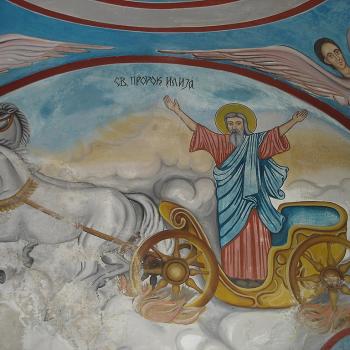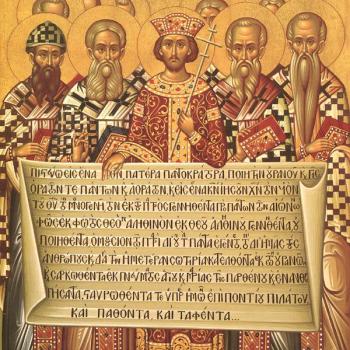 Many Christians read Scripture, and dogmatic teachings of their church, misunderstanding the means by which such texts should be interpreted. They think there is one simple meaning to the text, and when they find it, that is all they have to believe. Usually, this interpretation comes from the most simplistic, most literalistic reading of the text, ignoring basic hermeneutical questions in the process. Those with some scholarly inclinations will recognize that they must research the past, seek out the meanings of the words and concepts being used at the time in which they were employed, and then they will use what they learn to establish an interpretation through such means. While such research can be useful, it is also founded upon a faulty hermeneutic, one which ignores what Scripture (and church teaching) actually is: a symbolic means by which transcendental truths are presented to the reader.
Many Christians read Scripture, and dogmatic teachings of their church, misunderstanding the means by which such texts should be interpreted. They think there is one simple meaning to the text, and when they find it, that is all they have to believe. Usually, this interpretation comes from the most simplistic, most literalistic reading of the text, ignoring basic hermeneutical questions in the process. Those with some scholarly inclinations will recognize that they must research the past, seek out the meanings of the words and concepts being used at the time in which they were employed, and then they will use what they learn to establish an interpretation through such means. While such research can be useful, it is also founded upon a faulty hermeneutic, one which ignores what Scripture (and church teaching) actually is: a symbolic means by which transcendental truths are presented to the reader.
St. Maximos wrote the Confessor write that there can be an infinite number of interpretations which can emerge from Scripture: “For the divine word could never be circumscribed by a single interpretation, nor does it suffer confinement in a single meaning, on account of its natural infinity.”[1] This infinite meaning, of course, means no one, in and of themselves, possesses a complete understanding of the text, which is why St. Peter of Damaskos said, “For the saints neither know the whole of God’s purpose with regard to every object or scriptural text, nor on the other hand do they write down once and for all everything that they do know.”[2] Even the writers of such texts, inspired as they are, with a great understanding of the truth, do not comprehend the fullness of the truth which inspired them, nor do they write down all that they know or understand of that truth because much of the truth transcends words.
Because transcendent truths are being presented through conventional means, multiple interpretations are necessary in order to relate those truths to others. Each interpretation will reflect upon the text with a particular hermeneutic lens which will complement other interpretations which come out of the text. Some interpretations will present greater realizations of the truth than others, but, when it is understood that there is an infinite number of truths which can be intended out of a particular text, then even lesser interpretations can provide some help and aid to the faithful.
God is at work with Scripture, and with the church in its dogmatic declarations, using conventional representations of the truth which we can understand and uses them to direct us to the absolute truth found in himself. St. Maximos suggested that God knew this was the best way to direct us towards the truth: “God, who wisely and in due proportion takes thought for those under His providence, in the past used figures naturally suited to those ruled by sense perception in order to lead them to the truth, invisibly mingling Himself in all of the figures given to the ancient people, actively bringing about the spiritual elevation of those being instructed.” [3] When we become too attached to the means by which the truth is being presented, limiting the meaning to the letter of the text and not to the intention behind the text, we end up cutting ourselves from the life-affirming grace of the absolute which is how and why Paul could say that the letter kills, while the spirit which employs the letter gives life (cf. 2 Cor. 3:6).
In Scripture, God uses history and legend as the means by which he establishes symbols, hoping that we will come to realize the truth which he wants us to ascertain lies beyond the symbol and the history in which it was formed. For this reason, St. Maximos, and many others like him, suggest that our interest should not be in dissecting the historical story but rather, we should be seeking out what it means and redirect our interest to the spiritual truths being presented to us:
As much as we can, then, let us transpose the entirely Scripture to the level of the intellect, so that we might illumine the intellect through divine meanings, while making the body bright with the modes of the more divine principles that we have understood, making it a “rational workshop of virtues” by rejecting those passions that are inherent within us by nature.[4]
If we become too fixed with the symbols, too interested in analyzing them, absolutizing them in the most literal fashion, we miss the whole point of Scripture and the church’s dogmatic teachings, similar to the way someone could miss the point if they took an interest in a finger pointing out the way they should go instead of looking towards the destination a finger is pointing out. At different points in time, at different points on the trail, we might find fingers pointing different ways; if we just take the fingers apart from the context, and see they are pointing all kinds of different directions, it would seem as if we are being misdirected with self-contradictory declarations of where we should go, but if we understood the destination and the relative place we are in relation to the destination when each finger is presented, we would be following the meaning and not the finger and would find on contradiction in such assertions. Likewise, with Scripture, we can easily make statements in it contradict each other, but when we know the destination, and we see the relative relationship between each statement and the destination, we can discern the greater spiritual truth being portrayed and allow ourselves to be taken towards it and see how they stand together to point to the truth through a kind of symbolic triangulation.
Nikitas Stithatos warns us that if we want to receive the meaning of the text, we must silence ourselves in order to ascertain its spirit. Scripture often acts like a mirror on which we project our own desires and we end up seeing them reflected back at us. As long as we put our own thoughts and ideologies upon Scripture, our hermeneutical lens will be warped, leading to a distortion of the meaning:
Divine Scripture is to be interpreted spiritually and the treasures it contains are revealed only through the Holy Spirit to the spiritual. Hence the unspiritual man cannot receive the revelation of these treasures (cf. 1 Cor. 2:14). The ceaseless flow of his own thoughts makes it impossible for him to understand or listen to anything said by anyone else. [5]
It is for this reason, while we might grasp some small, and invaluable meaning from Scripture for ourselves, it often is riddled with distortions because the thoughts and ideas in our head interfere with our engagement with the text. As those who engage Scripture learn to silence themselves and allow the Spirit with grace demonstrate the higher truths being presented without any interference from their own mind, they will slowly learn more from the Spirit and become worthy interpreters of Scripture who should be heeded. They are the ones we need to go to as we find ourselves stumbling, riddled with noise in our lives, and find out what wisdom they can impart to us. If they are skilled at it, then, as St. Maximos suggested, they will deal with us according to our own spiritual conditioning. If we are ready to transcend the most simplistic understanding of the text, they will direct us to some of the higher truths they have obtained; if, on the other hand, we are not yet ready for that, they will direct us accordingly:
To speak about these matters with precision belongs solely to those who, on account of their great purity of intellect, have received from God all the fullness of the grace of the Spirit that human beings are capable of receiving. By means of this grace they cognitively transverse the ocean of mystical contemplations, beholding solely the inner principles of the words of Scripture stripped of their conventional figures. In general they say nothing concerning the figures by which the principles are symbolized, unless in their wisdom they should somewhere wish to express them in a corporeal manner for the sake of those who, because of their intellectual immaturity, cannot see beyond the level of the senses. Their hope is that such persons, having first exercised themselves with sense-perceptible figures, might acquire a longing to advance to the archetypical principles beyond the senses.[6]
Preachers, speaking to a large congregation, will likely speak on and about the conventional figures; they will be inspired by the wisdom which they have attained in their own spiritual journey, and so they can and will help those they speak to accordingly. They can and will speak of historical-critical analysis of the text as a means of preparing the reader to transcend the letter of the text: when one understands the letter and its limitations, one is ready to go beyond the foundations, the most simplistic reading of the text. Historical-critical research prevents us from absolutizing the text, of putting to much interest in the symbols being, in the stories being told as if the point of the text is that something interesting happened in the past. That is not the point of Scripture. That has never been the point. When we get caught up on the details of the story, we end up being stuck on the fingers pointing the way towards the truth instead of following the way itself. We must not confuse the symbols as being the stopping point of our embrace of the truth; rather, they must be seen as initiatory conventions which God uses to help us move beyond ourselves and towards the truth which can never be contained in words.
[IMG= Pointing the Way by agracier – NO VIEWS [CC BY-SA 3.0 (https://creativecommons.org/licenses/by-sa/3.0)], via Wikimedia Commons]
[1] St. Maximos the Confessor, On Difficulties in Sacred Scripture: The Response to Thalassios. Trans. Fr. Maximos Constas (Washington, DC: CUA Press, 2018), 77.
[2] St. Peter of Damaskos, “Twenty-Four Discourses XXIII: Holy Scripture” in The Philokalia: The Complete Text. Volume Three. Trans and ed. G.E.H. Palmer, Philip Sherrard and Kallistos Ware (London: Faber and Faber, 1984), 265.
[3] St. Maximos the Confessor, On Difficulties in Sacred Scripture: The Response to Thalassios, 202.
[4] St. Maximos the Confessor, On Difficulties in Sacred Scripture, 323.
[5] Nikitas Stithatos, “On Spiritual Knowledge,” in The Philokalia: The Complete Text. Volume Four. Trans and ed. G.E.H. Palmer, Philip Sherrard and Kallistos Ware (London: Faber and Faber, 1995), 165.
[6] St. Maximos the Confessor, On Difficulties in Sacred Scripture: The Response to Thalassios, 355-6.
Stay in touch! Like A Little Bit of Nothing on Facebook












